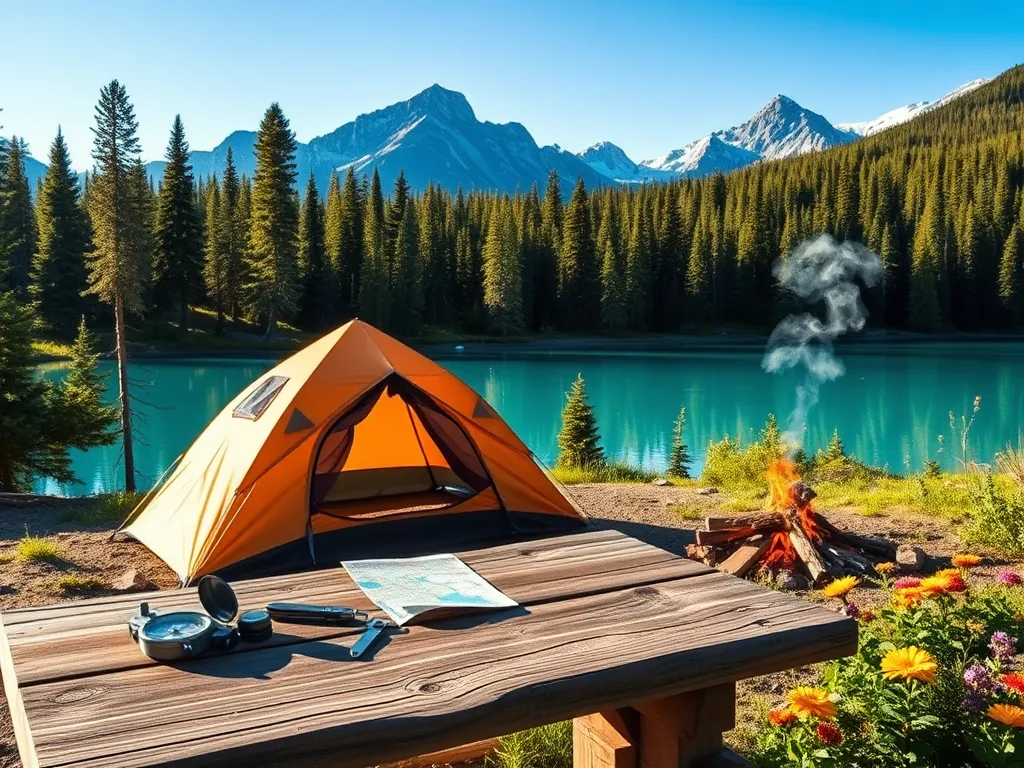Surviving the Great Outdoors: Tips for Canadian Adventures

Surviving the Great Outdoors
Surviving the Great Outdoors is not just a pursuit for adventure lovers; it’s an essential skill for anyone who wishes to explore nature responsibly and safely. Whether embarking on a camping trip, hiking through the wilderness, or simply enjoying a day in the park, understanding how to survive in the outdoors is crucial. This article will guide you through essential tips and knowledge that will help you thrive in natural environments.
When it comes to Surviving the Great Outdoors, preparation is key. This includes understanding the environment you will be in, knowing what safety gear to bring, and being aware of potential wildlife encounters. The right mindset and knowledge can make the difference between a fun outdoor experience and a dangerous situation. Planning ahead by assessing risks and preparing accordingly will help you face challenges head-on. Therefore, let us delve into some important aspects of outdoor survival techniques.
A critical aspect of Surviving the Great Outdoors is being equipped with the right outdoor safety gear. Essential items like weather-appropriate clothing, navigation tools, first-aid supplies, and emergency food and water are indispensable for any outdoor explorer. By packing these items, you ensure that you are prepared for various scenarios and have the necessary support to enjoy your adventure to the fullest.
Another vital component of Surviving the Great Outdoors is wildlife awareness. Understanding which animals inhabit the area and how to safely navigate encounters with them will greatly increase your safety. Knowing how to respond in the unlikely event of an animal attack and educating yourself about animal behaviors can prevent dangerous situations and enhance your outdoor experience.
Weather preparedness is equally important in Surviving the Great Outdoors. Canada’s diverse climate means being ready for sudden weather changes. It’s essential to familiarize yourself with local climate patterns, learn to read weather forecasts, and prepare adequately for the season you are in, especially when it comes to winter activities.
Outdoor Safety Gear
Essential clothing for Canadian weather varies significantly depending on the season and region. Layering is key for temperature regulation, consisting of a moisture-wicking base layer, an insulating mid-layer, and a waterproof outer layer. Accessories such as hats, gloves, and thermal socks are also crucial during colder months to keep heat from escaping the body, allowing you to stay warm and dry during your outdoor activities.
Navigation tools like maps and compasses remain vital for outdoor survival. Although GPS technology is widely used, it’s not always reliable in remote areas or during poor weather. Understanding how to read a topographic map and use a compass will help you locate your position accurately and navigate through the wilderness safely, ensuring you don’t become lost in unfamiliar terrain.
A well-stocked first-aid kit is a must-have for Surviving the Great Outdoors. Include items such as adhesive bandages, antiseptic wipes, gauze pads, pain relievers, tweezers, and a first-aid manual. Familiarize yourself with how to use these supplies effectively, so you can provide assistance in case of injuries or medical emergencies while outdoors.
Emergency food and water supplies should always be part of your outdoor gear. Carry portable food items like power bars, dried fruits, and nuts that are energy-dense and easy to pack. Additionally, having a reliable water purification method—like water purification tablets or a portable filter—will ensure that you have access to safe drinking water, especially in remote areas where clean water sources might be scarce.
Wildlife Awareness
Identifying dangerous animals is crucial for staying safe while exploring the outdoors. Common threats may include bears, moose, snakes, and various insects. Learning to recognize tracks, sounds, and behaviors of these animals can alert you to their presence, helping you avoid unnecessary encounters that could put you at risk.
To avoid wildlife encounters, make noise while moving through the woods, as quietness often attracts curious animals. Travel in groups, keep food secured, and never approach or feed wildlife. Understanding the trails and habitats of local wildlife can also guide your activities in a safer direction, allowing you to enjoy nature without interference.
In the rare event of an animal attack, knowing how to respond can make a life-saving difference. For example, if confronted by a bear, remain calm, speak softly, and try to back away slowly. Never run, as this may trigger a chase response. Understanding the proper actions for specific types of animal encounters will help you stay safe and composed during emergencies.
Understanding animal behavior in the wild is essential in Surviving the Great Outdoors. Many predators prefer to avoid humans, but young or aggressive animals may behave unpredictably. Educating yourself about common wildlife behaviors, such as how animals perceive threats and their reaction patterns, can help you make better decisions while navigating their habitats and reduce the likelihood of dangerous encounters.
Weather Preparedness
Understanding Canadian climate patterns is fundamental to Surviving the Great Outdoors. Weather conditions can change rapidly, and regions can differ greatly in terms of temperature and precipitation. Familiarize yourself with the typical weather trends for the area you plan to explore, and always check forecasts leading up to your adventure to ensure you’re prepared for what’s ahead.
Learning how to read weather forecasts can greatly enhance your outdoor adventures. Pay attention to local news, weather apps, and color-coded alerts. Understanding indicators of impending storms, severe weather threats, or temperature drops will enable you to adjust your plans and stay safe while enjoying nature.
Dealing with sudden weather changes is a crucial skill for outdoor survival. Develop the ability to recognize early signs of a storm or temperature drop, and have contingency plans in place. If conditions worsen and pose a threat, knowing when to head back or seek shelter can prevent you from becoming trapped in dangerous situations. Always carry rain gear, extra layers, and emergency supplies in case of unexpected weather shifts.
Preparing for winter outdoor activities requires specific strategies to Survive the Great Outdoors effectively. Ensure that you have winter-appropriate gear, such as insulated boots and sleeping bags. Stay informed about conditions and potential hazards like frostbite or hypothermia. Understanding how to adapt to cold weather ensures that your winter adventures remain enjoyable and safe.
Camping Safety Tips
Setting up a safe campsite is the first step in ensuring a successful outdoor experience. Choose locations away from hazards like falling branches or near water. Use established campgrounds or clearings when available, and adhere to Leave No Trace principles to protect the environment. Establish a safe perimeter and bear-proof food storage to keep wildlife at bay.
Fire safety guidelines for camping are paramount. Always follow local regulations regarding campfires and ensure that your fire is fully contained in a designated pit. Keep water or sand nearby to extinguish the fire completely when finished, and never leave a fire unattended. Understanding how to build and manage a fire safely can provide warmth, security, and a means for cooking food.
Dealing with insects and pests is essential for comfort while camping. Use insect repellent containing DEET for protection against mosquitoes and ticks. Setting up screens can help keep insects away from your camp area. Understanding how to recognize ticks and their potential risks is essential, as early detection can prevent illnesses such as Lyme disease.
Keeping food safe from wildlife while camping requires careful planning. Store food in bear-proof containers and away from sleeping areas. Avoid leaving food scraps behind, and dispose of waste properly to minimize attracting animals. Implementing these strategies will help you enjoy your camping experience without the worry of animals raiding your supplies.
Hiking Best Practices
Choosing safe hiking trails is imperative for Surviving the Great Outdoors. Research the trail difficulty, length, and elevation before committing to a hike. Ensure the trails are appropriate for your skill level, and consider factors like weather conditions and wildlife presence. Always inform someone of your plans and expected return to enhance safety.
Packing essentials for day hikes can make or break your outdoor experience. Carry water, nutritious snacks, a map, a first-aid kit, and a fully charged phone or GPS device. Depending on the duration and environment, additional items such as rain gear, sun protection, and a multi-tool may also be vital. Being overprepared is better than underprepared when it comes to hiking safety.
Navigating in the backcountry requires specific skills and tools. Familiarize yourself with reading maps and using compasses, as well as understanding landmarks in the area. Develop the ability to track progress and stay oriented, especially in remote areas without cellular service. Practicing these navigation skills will reduce the risk of getting lost and enhance your confidence in the wilderness.
Recognizing signs of fatigue and knowing how to respond is essential for safe hiking. Listen to your body and be mindful of symptoms like dizziness, excessive thirst, or loss of coordination. If you or a fellow hiker are showing signs of fatigue, consider taking a break, hydrating, and eating nutrition-rich snacks. Prioritizing health and safety ensures a more enjoyable hiking experience.
